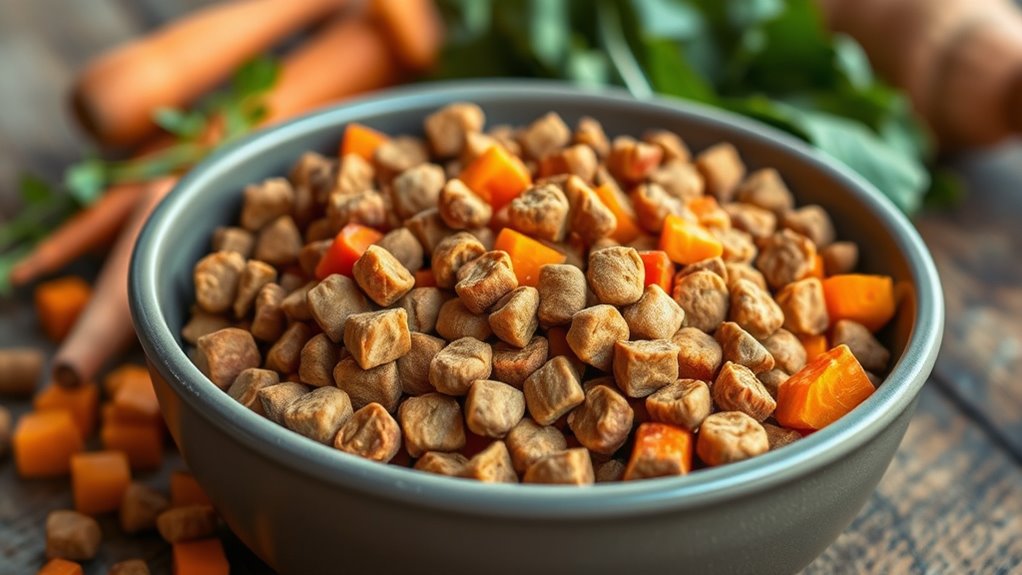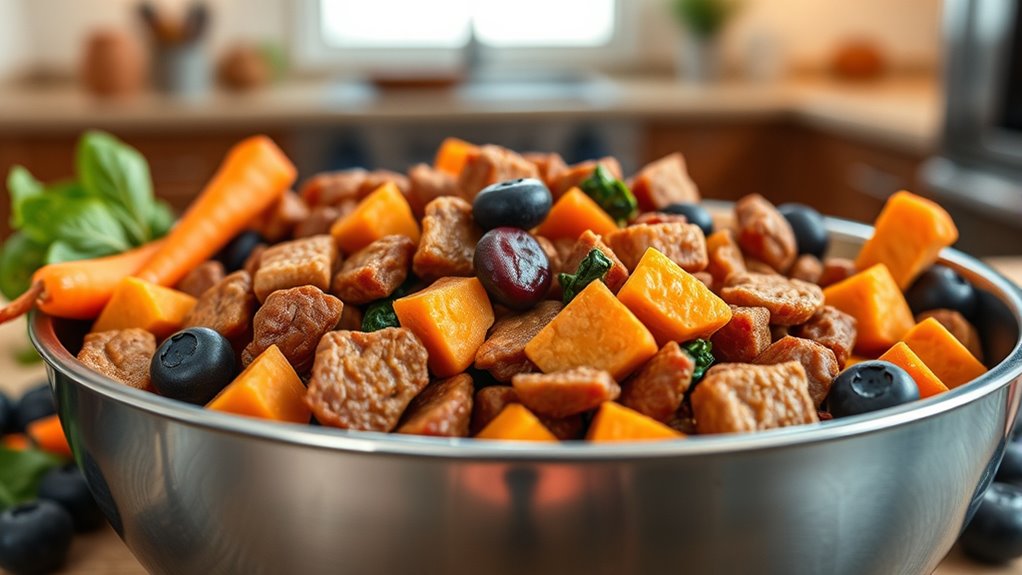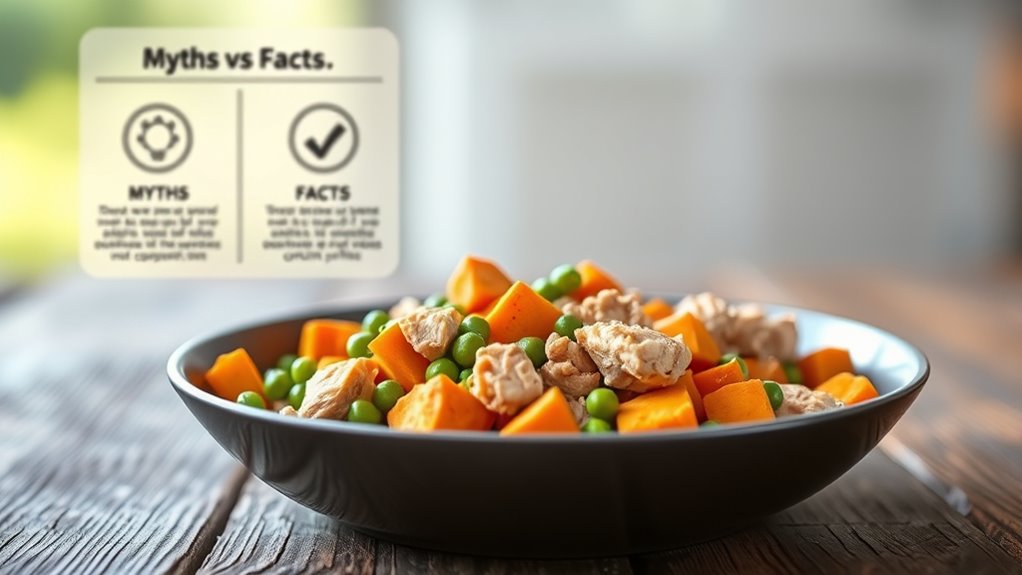Grain-free dog food became popular because pet owners believe it promotes health by eliminating fillers and focusing on high-quality ingredients. However, myths say grains cause allergies or are unnecessary, but research shows they provide essential nutrients and energy. While some dogs may have sensitivities, removing grains isn’t always better; it can risk nutritional imbalances. To make smart choices, learn what to look for in balanced, transparent formulas—there’s more to contemplate if you’re curious.
Key Takeaways
- Grain-free diets are popular for holistic wellness but may not be necessary or healthier for all dogs.
- Myths that grains cause allergies are false; proteins like beef or dairy are more common triggers.
- Carbohydrates from grains or alternatives like sweet potatoes provide essential energy and support digestion.
- Potential health risks, including heart issues, highlight the importance of veterinary guidance for grain-free diets.
- Transparent labeling and balanced nutrition are crucial when selecting grain-free dog foods to ensure safety and health.
The Rise of Grain-Free Diets: Why Are Pet Owners Choosing This Path?

Many pet owners are turning to grain-free diets because they believe these foods can improve their dogs’ health and well-being. They seek holistic wellness, aiming to support their pets’ overall vitality and balance. One key reason for this shift is ingredient transparency, as owners want to know exactly what’s in their dog’s food and avoid fillers or unknown additives. Grain-free options often highlight real, high-quality proteins and wholesome ingredients, giving owners peace of mind. This focus on natural, transparent ingredients aligns with a desire to provide their dogs with a more natural diet. By choosing grain-free, owners hope to promote better digestion, healthier coats, and increased energy, making their pets feel and look better. Additionally, many owners are influenced by the popularity of anime movies that emphasize natural and wholesome themes, reflecting a growing preference for healthier lifestyles for their pets. Understanding the nutritional balance in these diets is crucial to ensure their pets receive all essential nutrients, especially since some concerns have been raised about potential nutrient deficiencies.
Common Myths About Grain-Free Dog Food Debunked

Despite the popularity of grain-free dog food, several misconceptions persist that can mislead pet owners. One common myth is that grains cause allergies in dogs; however, grains rarely trigger allergic reactions, which are more often linked to ingredients like beef or dairy. Many believe that removing grains means your dog won’t get enough carbohydrates, but this is a misconception. Dogs can thrive on alternative carbohydrate sources such as sweet potatoes or peas. The idea that grains are inherently unhealthy or unnecessary is also false. In reality, grains can provide essential nutrients and fiber. Additionally, some studies suggest that grain-free diets may be linked to certain health issues, emphasizing the importance of balanced nutrition for overall health. Proper understanding of nutritional balance helps ensure your dog receives a complete diet. Recognizing the role of veterinary guidance is vital in making informed dietary decisions. Understanding these facts helps you make informed choices about your dog’s diet, avoiding unnecessary fears around grains and allergies and debunking the carbohydrate misconceptions that circulate in pet nutrition discussions. Moreover, recent research findings highlight the importance of individualized dietary plans tailored to each dog’s specific needs, rather than broad generalizations.
The Role of Carbohydrates and Grains in Canine Nutrition

Carbohydrates, including grains, play an essential role in supporting your dog’s energy needs and overall health. They serve as a primary energy source, helping maintain activity levels and ideal brain function. Carbohydrate sources vary widely, from grains like rice and oats to grain alternatives such as sweet potatoes and peas. These options provide vital nutrients, fiber, and digestibility. While some believe grains are unnecessary, they can be beneficial when balanced properly in your dog’s diet. Grain alternatives often offer similar nutritional benefits without traditional grains, making them suitable for dogs with sensitivities. Understanding the Nutritional benefits of grains and carbohydrate sources is well-documented in canine nutrition research. Incorporating a variety of carbohydrate sources can also support digestive health and aid in weight management for your dog. Additionally, modern research highlights how grain-inclusive diets can contribute to a balanced canine diet when appropriately formulated.
Understanding the Potential Health Risks of Grain-Free Diets

While grain-free diets have gained popularity among dog owners, they may pose certain health risks that are important to contemplate. One concern is the potential for grain allergies, which some dogs might develop or have already. Eliminating grains doesn’t guarantee fewer allergies and could lead to other sensitivities. Additionally, these diets may impact your dog’s digestive health. Some grain-free formulas replace grains with ingredients like legumes or potatoes, which can be harder for dogs to digest and may cause gastrointestinal issues such as diarrhea or bloating. Moreover, lacking certain nutrients found in grains, these diets might lead to nutritional imbalances if not carefully formulated. It’s essential to understand these risks to make an informed decision about your dog’s diet and overall health. Proper nutrition is crucial for maintaining your pet’s well-being and preventing potential deficiencies. Furthermore, some grain-free diets have been linked to heart health concerns, highlighting the importance of consulting with your veterinarian before making significant dietary changes. Additionally, understanding the nutritional content of various ingredients can help you better evaluate the suitability of a grain-free diet for your dog. Recognizing the importance of balanced diets can aid in avoiding unintended health issues related to dietary choices. Research also indicates that certain ingredient choices in grain-free formulas may contribute to health risks, emphasizing the need for careful ingredient selection.
Making Informed Choices: What to Look for in a Quality Dog Food

Choosing a high-quality dog food requires careful consideration of ingredients and nutritional content. Look for products with clear ingredient sourcing, so you know where the ingredients come from and that they meet safety standards. Label transparency is essential—reliable brands list every ingredient and specify their sources, helping you avoid unknown fillers or low-quality components. Check the guaranteed analysis to ensure the food provides balanced nutrients for your dog’s age and health needs. Avoid vague terms like “meat by-products” and opt for specific, recognizable ingredients such as “chicken” or “salmon.” By paying attention to ingredient sourcing and label transparency, you can make informed choices that support your dog’s health and well-being, giving you peace of mind with every meal. Additionally, understanding quality assurance standards can help you select products that meet industry safety and nutritional benchmarks. Ensuring the product complies with industry certifications further guarantees your dog’s food is held to rigorous safety and quality standards.
Frequently Asked Questions
How Do Grain-Free Diets Impact a Dog’S Energy Levels?
You might wonder how grain-free diets affect your dog’s energy levels. These diets can influence energy metabolism because they often have higher protein and fat, which can boost stamina. However, because they contain fewer carbs, your dog’s carbohydrate absorption decreases, potentially reducing quick energy boosts. Ultimately, your dog’s activity level depends on overall nutrition, so monitor their response and adjust their diet to maintain ideal energy.
Are Grain-Free Foods Suitable for All Dog Breeds?
You might wonder if grain-free foods suit all dog breeds. Breed suitability varies, so some breeds may benefit more than others. Age considerations also matter; puppies, seniors, or dogs with health issues might require specific diets. Always consult your vet to assess your dog’s unique needs. While grain-free options can be advantageous, they aren’t universally ideal, so personalized advice helps ensure your dog’s well-being.
What Are the Signs of Nutritional Deficiencies in Grain-Free Diets?
Imagine your dog’s health as a finely tuned orchestra; missing instruments can cause dissonance. Signs of nutritional deficiencies on a grain-free diet include Vitamin imbalances, such as dull coat or lethargy, and digestive issues like gas or diarrhea. If you notice these, it might be time to review their diet with your vet. Regular check-ups help make certain your dog’s nutritional harmony stays intact.
How Do Grain-Free Options Compare Price-Wise to Traditional Dog Foods?
You’ll find that grain-free dog foods often cost more than traditional options due to ingredient sourcing, which tends to be higher quality and more specialized. The cost comparison varies depending on brands and ingredients used, but generally, grain-free formulas are pricier because of premium ingredients and limited supply chains. While they might seem like a splurge, many pet owners believe the benefits justify the extra expense.
Can Grain-Free Diets Help With Specific Allergies or Sensitivities?
If your dog has grain allergies or food sensitivities, switching to a grain-free diet might help reduce their symptoms. You could notice improvements in itching, digestive issues, or skin problems. However, it’s crucial to consult your vet first, as some dogs may have sensitivities to other ingredients. Grain-free options are designed to avoid grains that trigger allergies, offering a tailored diet that supports your dog’s health and comfort.
Conclusion
Choosing a grain-free diet is like steering through a maze—you need to trust what’s fact and what’s fiction. I once met a dog owner who switched to grain-free and saw her pup thrive, but others faced unexpected health issues. Remember, like any puzzle, understanding your dog’s needs and reading labels carefully helps you make the best choice. Stay informed, and your furry friend will enjoy a happy, healthy life by your side.










